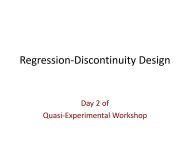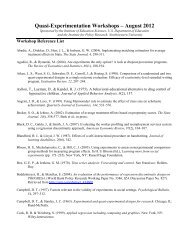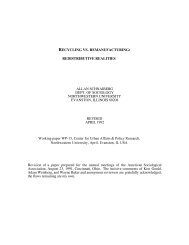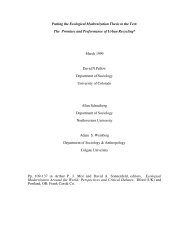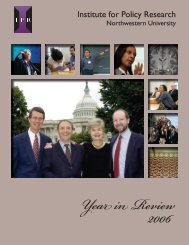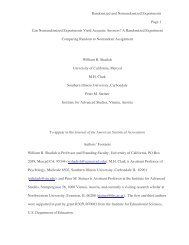Whatever Happened to the Emerging Democratic Majority?
Whatever Happened to the Emerging Democratic Majority?
Whatever Happened to the Emerging Democratic Majority?
Create successful ePaper yourself
Turn your PDF publications into a flip-book with our unique Google optimized e-Paper software.
12<br />
Policy Perspective<br />
H<br />
IV/AIDS Among People of Color:<br />
Think Local, Not Just Global<br />
By Megan Comfort and Celeste Watkins<br />
In tracking <strong>the</strong> spread of HIV/AIDS, American media attention<br />
has rightly focused on <strong>the</strong> global epidemic, which in 2004<br />
encompassed 40 million people living with HIV and 3.1<br />
million lives lost <strong>to</strong> AIDS. The media particularly emphasize<br />
<strong>the</strong> devastating rates of HIV infection in regions such as sub-<br />
Saharan Africa, where 60 percent of all people infected with<br />
HIV reside. Not surprisingly, this has led many Americans <strong>to</strong><br />
associate HIV and AIDS with people in distant lands. Yet a crisis<br />
of epidemic proportions is brewing right here at home.<br />
Compounding <strong>the</strong> perception<br />
that HIV infection happens <strong>to</strong><br />
<strong>the</strong> irresponsible or immoral<br />
are persistent racial attitudes<br />
that tend <strong>to</strong> blame people of<br />
color almost exclusively for <strong>the</strong><br />
social, economic, and political<br />
disadvantages <strong>the</strong>y suffer.<br />
According <strong>to</strong> <strong>the</strong> Centers for Disease Control and<br />
Prevention, African Americans represent 12 percent of <strong>the</strong><br />
<strong>to</strong>tal U.S. population, but were estimated <strong>to</strong> account for 50<br />
percent of <strong>the</strong> HIV and AIDS cases diagnosed among adults<br />
in 2003. In <strong>the</strong> U.S., <strong>the</strong> AIDS diagnosis rate is 23 times higher<br />
for black women and fi ve times higher for Hispanic women<br />
than <strong>the</strong>ir white counterparts. Black men are diagnosed at<br />
nine times and Hispanic men at three times <strong>the</strong> rate of AIDS<br />
for white men. African Americans, followed by Hispanics, also<br />
have <strong>the</strong> poorest survival rates among people diagnosed with<br />
AIDS.<br />
It is time <strong>to</strong> sound <strong>the</strong> alarm.<br />
If HIV infection and AIDS mortality continue at <strong>the</strong> current<br />
rates, many of America’s communities of color will face a public<br />
health threat more akin <strong>to</strong> that of an impoverished country<br />
than a prosperous and technologically advanced nation.<br />
Were upper-class white heterosexual Americans at risk—or<br />
even perceived <strong>to</strong> be at risk—for HIV/AIDS at <strong>the</strong> same rates<br />
as low-income people of color, our country’s <strong>to</strong>p-ranking<br />
officials would presumably take notice. They would fully engage<br />
<strong>the</strong> country in rigorous proposals for <strong>the</strong> design, funding,<br />
and implementation of a massive prevention and treatment<br />
campaign. Instead, <strong>the</strong> issue goes largely unnoticed by <strong>the</strong><br />
general public and our national leaders.<br />
Case in point: In response <strong>to</strong> a question about rising HIV<br />
rates among Americans of color in <strong>the</strong> vice-presidential<br />
debates in fall 2004, John Edwards talked broadly about access<br />
<strong>to</strong> health care, and Dick Cheney admitted he was not aware<br />
that HIV/AIDS was reaching epidemic proportions among<br />
African American women.<br />
Underlying <strong>the</strong> muted national reaction <strong>to</strong> <strong>the</strong> HIV/AIDS<br />
crisis among African Americans and Hispanics is a culture of<br />
blame. Fixation on <strong>the</strong> mode of infection shapes a distancing<br />
response <strong>to</strong> <strong>the</strong> disease, as HIV is cast as <strong>the</strong> consequence of<br />
imprudent, reckless, or dissolute behavior. Compounding <strong>the</strong><br />
perception that HIV infection happens <strong>to</strong> <strong>the</strong> irresponsible<br />
or immoral are persistent racial attitudes that tend <strong>to</strong> blame<br />
people of color almost exclusively for <strong>the</strong> social, economic,<br />
and political disadvantages <strong>the</strong>y suffer.<br />
While race and ethnicity are not inherently risk fac<strong>to</strong>rs<br />
for HIV infection, African Americans and Hispanics are<br />
disproportionately afflicted by poverty, lack of access <strong>to</strong> medical<br />
information and care, incarceration, and o<strong>the</strong>r hazardous health<br />
experiences that result in increased vulnerability <strong>to</strong> HIV<br />
exposure. HIV infection is not simply about who does what,<br />
but ra<strong>the</strong>r ways in which destitution, racism, and extreme social<br />
marginalization jeopardize people’s physical and emotional<br />
health. These social conditions increase <strong>the</strong> likelihood that<br />
people will engage in unprotected acts with those in whom<br />
HIV is undiagnosed or untreated.<br />
Our country’s senior offi cials cannot be allowed <strong>to</strong> plead<br />
continued ignorance <strong>to</strong> a preventable epidemic. Medical<br />
providers, research centers, and community organizations must<br />
be resourced and empowered <strong>to</strong> continue making important<br />
headway—not hindered by ideological debates that undermine<br />
<strong>the</strong>ir prevention and treatment measures.<br />
Education and public awareness about <strong>the</strong> serious threat<br />
posed by HIV and AIDS <strong>to</strong> America’s communities of color<br />
must begin at <strong>the</strong> highest levels of political leadership so that<br />
<strong>the</strong> nation can act collectively <strong>to</strong> protect <strong>the</strong> health and wellbeing<br />
of all of its people.<br />
Megan Comfort is a research specialist at <strong>the</strong> Center for AIDS<br />
Prevention Studies, University of California, San Francisco.<br />
Celeste Watkins is an assistant professor of sociology and African<br />
American studies and a faculty fellow at <strong>the</strong> Institute for Policy<br />
Research at Northwestern University.



